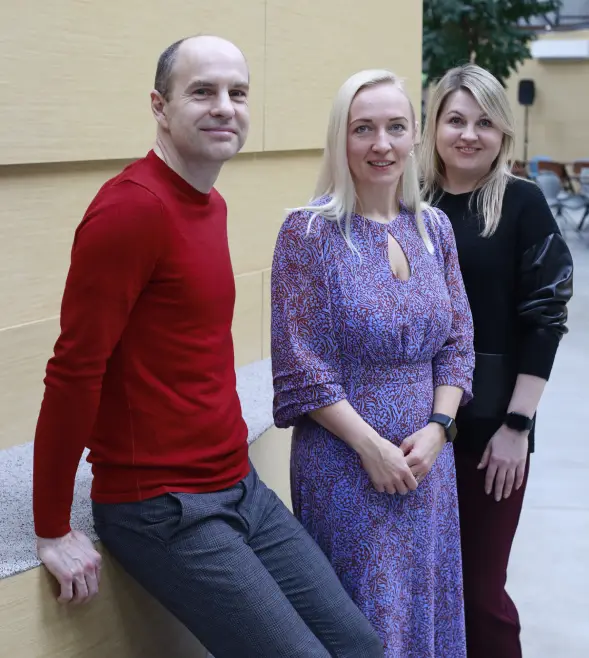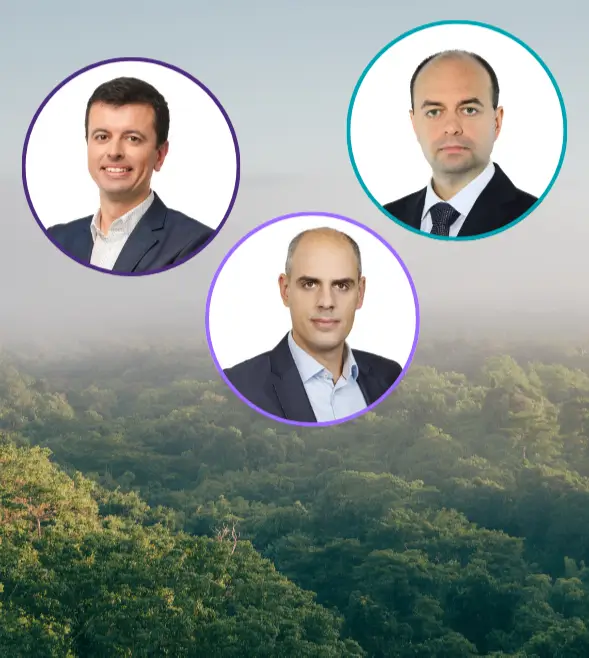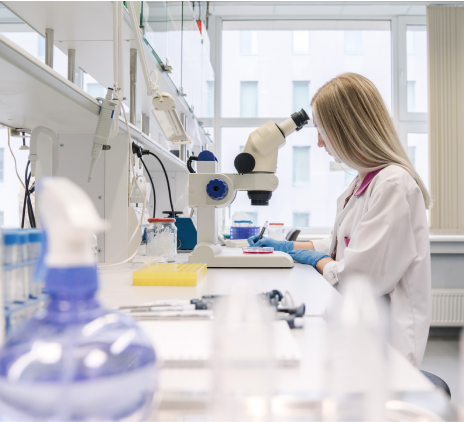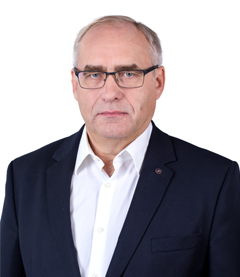-
Other audit services
We help clients with the application and use of foreign financial aid of EU and other funds and help prepare financial reports.
-
Audit calculator
The calculator will answer if the company's sales revenue, assets or number of employees exceed the limit of an inspection or audit.
-
Payroll and related services
We perform payroll accounting for companies whether they employ a few or hundreds of employees.
-
Tax accounting
Grant Thornton Baltic's experienced tax specialists support accountants and offer reasonable and practical solutions.
-
Reporting
We prepare annual reports in a timely manner. We help to prepare management reports and various mandatory reports.
-
Consolidation of financial statements
Our experienced accountants and advisors help you prepare consolidation tables and make the consolidation process more efficient.
-
Consultancy and temporary staff
Our experienced specialists advise on more complex accounting transactions, rectify poor historic accounting, and offer the temporary replacement of an accountant.
-
Outsourced CFO service
Our CFO service is suitable for companies of all sizes and in all industries. We offer services to our clients in the required amount and competences.
-
Assessment of accounting processes
We help companies to implement accounting practices that are in compliance with local and international standards.
-
Accounting services for small businesses
We offer affordable service for small businesses. We help organize processes as smartly and cost-effectively as possible.
-
Cryptocurrency accounting
We keep up with blockchain technology to serve and advise crypto companies. We are supported by a network of colleagues in 130 countries.
-
Trainings and seminars
Our accountants have experience in all matters related to accounting and reporting. We offer our clients professional training according to their needs.

-
Business advisory
We offer legal support to both start-ups and expanding companies, making sure that all legal steps are well thought out in detail.
-
Fintech advisory
Our specialists advise payment institutions, virtual currency service providers and financial institutions.
-
Corporate advisory
We advise on legal, tax and financial matters necessary for better management of the company's legal or organizational structure.
-
Transaction advisory
We provide advice in all aspects of the transaction process.
-
Legal due diligence
We thoroughly analyze the internal documents, legal relations, and business compliance of the company to be merged or acquired.
-
In-house lawyer service
The service is intended for entrepreneurs who are looking for a reliable partner to solve the company's day-to-day legal issues.
-
The contact person service
We offer a contact person service to Estonian companies with a board located abroad.
-
Training
We organize both public trainings and tailor made trainings ordered by clients on current legal and tax issues.
-
Whistleblower channel
At Grant Thornton Baltic, we believe that a well-designed and effective reporting channel is an efficient way of achieving trustworthiness.

-
Business model or strategy renewal
In order to be successful, every company, regardless of the size of the organization, must have a clear strategy, ie know where the whole team is heading.
-
Marketing and brand strategy; creation and updating of the client management system
We support you in updating your marketing and brand strategy and customer management system, so that you can adapt in this time of rapid changes.
-
Coaching and development support
A good organizational culture is like a trump card for a company. We guide you how to collect trump cards!
-
Digital services
Today, the question is not whether to digitize, but how to do it. We help you develop and implement smart digital solutions.
-
Sales organisation development
Our mission is to improve our customers' business results by choosing the right focuses and providing a clear and systematic path to a solution.
-
Business plan development
A good business plan is a guide and management tool for an entrepreneur, a source of information for financial institutions and potential investors to make financial decisions.
-
Due diligence
We perform due diligence so that investors can get a thorough overview of the company before the planned purchase transaction.
-
Mergers and acquisitions
We provide advice in all aspects of the transaction process.
-
Valuation services
We estimate the company's market value, asset value and other asset groups based on internationally accepted methodology.
-
Forensic expert services
Our experienced, nationally recognized forensic experts provide assessments in the economic and financial field.
-
Business plans and financial forecasts
The lack of planning and control of cash resources is the reason often given for the failure of many businesses. We help you prepare proper forecasts to reduce business risks.
-
Outsourced CFO service
Our CFO service is suitable for companies of all sizes and in all industries. We offer services to our clients in the required amount and competences.
-
Reorganization
Our experienced reorganizers offer ways to overcome the company's economic difficulties and restore liquidity in order to manage sustainably in the future.
-
Restructuring and reorganisation
We offer individual complete solutions for reorganizing the structure of companies.
-
Corporate taxation
We advise on all matters related to corporate taxation.
-
Value added tax and other indirect taxes
We have extensive knowledge in the field of VAT, excise duties and customs, both on the national and international level.
-
International taxation
We advise on foreign tax systems and international tax regulations, including the requirements of cross-border reporting.
-
Transfer pricing
We help plan and document all aspects of a company's transfer pricing strategy.
-
Taxation of transactions
We plan the tax consequences of a company's acquisition, transfer, refinancing, restructuring, and listing of bonds or shares.
-
Taxation of employees in cross-border operations
An employee of an Estonian company abroad and an employee of a foreign company in Estonia - we advise on tax rules.
-
Tax risk audit
We perform a risk audit that helps diagnose and limit tax risks and optimize tax obligations.
-
Representing the client in Tax Board
We prevent tax problems and ensure smooth communication with the Tax and Customs Board.
-
Taxation of private individuals
We advise individuals on personal income taxation issues and, represent the client in communication with the Tax and Customs Board.
-
Pan-Baltic tax system comparison
Our tax specialists have prepared a comparison of the tax systems of the Baltic countries regarding the taxation of companies and individuals.
-
Internal audit
We assist you in performing the internal audit function, performing internal audits and advisory work, evaluating governance, and conducting training.
-
Internal Audit in the Financial Services Sector
We provide internal audit services to financial sector companies. We can support the creation of an internal audit function already when applying for a sectoral activity license.
-
Audit of projects
We conduct audits of projects that have received European Union funds, state aid, foreign aid, or other grants.
-
Prevention of money laundering
We help to prepare a money laundering risk assessment and efficient anti-money laundering procedures, conduct internal audits and training.
-
Risk assessment and risk management
We advise you on conducting a risk assessment and setting up a risk management system.
-
Custom tasks
At the request of the client, we perform audits, inspections and analyzes with a specific purpose and scope.
-
External Quality Assessment of the Internal Audit Activity
We conduct an external evaluation of the quality of the internal audit or provide independent assurance on the self-assessment.
-
Whistleblowing and reporting misconduct
We can help build the whistleblowing system, from implementation, internal repairs and staff training to the creation of a reporting channel and case management.
-
Information security management
We provide you with an information security management service that will optimise resources, give you an overview of the security situation and ensure compliance with the legislation and standards.
-
Information security roadmap
We analyse your organisation to understand which standards or regulations apply to your activities, identify any gaps and make proposals to fix them.
-
Internal audit of information security
Our specialists help detect and correct information security deficiencies by verifying an organization's compliance with legislation and standards.
-
Third party management
Our specialists help reduce the risks associated with using services provided by third parties.
-
Information security training
We offer various training and awareness building programmes to ensure that all parties are well aware of the information security requirements, their responsibilities when choosing a service provider and their potential risks.
-
Digital Operational Resilience Act (DORA)
We will help you create a DORA implementation model that meets your company's needs and ensures that you meet the January 2025 deadline.

-
ESG advisory
We help solve issues related to the environment, social capital, employees, business model and good management practices.
-
ESG audit
Our auditors review and certify sustainability reports in line with international standards.
-
Sustainable investments
We help investors conduct analysis of companies they’re interested in, examining environmental topics, corporate social responsibility and good governance practices.
-
Sustainable tax behaviour
Our international taxation specialists define the concept of sustainable tax behaviour and offer services for sustainable tax practices.
-
ESG manager service
Your company doesn’t necessarily need an in-house ESG manager. This role can also be outsourced as a service.

-
Recruitment services – personnel search
We help fill positions in your company with competent and dedicated employees who help realize the company's strategic goals.
-
Recruitment support services
Support services help to determine whether the candidates match the company's expectations. The most used support services are candidate testing and evaluation.
-
Implementation of human resource management processes
We either assume a full control of the launch of processes related to HR management, or we are a supportive advisory partner for the HR manager.
-
Audit of HR management processes
We map the HR management processes and provide an overview of how to assess the health of the organization from the HR management perspective.
-
HR Documentation and Operating Model Advisory Services work
We support companies in setting up HR documentation and operational processes with a necessary quality.
-
Employee Surveys
We help to carry out goal-oriented and high-quality employee surveys. We analyse the results, make reports, and draw conclusions.
-
HR Management outsourcing
We offer both temporary and permanent/long-term HR manager services to companies.

-
Digital strategy
We help assess the digital maturity of your organization, create a strategy that matches your needs and capabilities, and develop key metrics.
-
Intelligent automation
We aid you in determining your business’ needs and opportunities, as well as model the business processes to provide the best user experience and efficiency.
-
Business Intelligence
Our team of experienced business analysts will help you get a grip on your data by mapping and structuring all the data available.
-
Cybersecurity
A proactive cyber strategy delivers you peace of mind, allowing you to focus on realising your company’s growth potential.
-
Innovation as a Service
On average, one in four projects fails and one in two needs changes. We help manage the innovation of your company's digital solutions!

Author: Rivo Sarapik, Äripäev
Though analysts consider the agricultural sector as having high potential for the next year, their optimism doesn’t always pan out. Farmers have to expend effort and cooperate to overcome challenges, as a radio programme produced by the Äripäev business daily, “Kasvukursil” revealed.
Meelis Annus, the head of Kevili, an agricultural association uniting 160 producers that featured in the Äripäev business daily rankings of most successful companies, says that one thing to evaluate when gauging the success of agricultural enterprises is whether it is a producer or intermediary. “Merchants may have better years, and in our case, our turnover may also end up being 70 million euros instead of the expected 60 million euros,” he said. “In the case of an actual producer, it should be considered that the sales are distributed over a number of years.”
Annus cited the example that production volumes have set records this year in a number of places but it doesn’t necessarily mean that profits have grown because the price of produce has dropped. “The monetary volume may not be big," he ventured.
Annus said agriculture sector must be viewed in the long term perspective. He said there were years where farmers’ income wasn‘t enough to service their financial obligations. “Years like that were 2013, 2016 and 2018, where income was lower than the amounts needed to repay loans.”
While analysts are expecting major investments from the agriculture sector in the years ahead, Annus isn’t as optimistic. "No doubt the need for investment has grown because last year (2018) was thin, but ultimately it's the things that are needed that get funded,” he said, noting that farmers know that they have to keep a liquidity reserve to cover possible meagre years and this keeps them from investing too much.
Mindsets changing
Annus said the year 2019 will be better than last, which had a dry summer, because farmers were able to turn the heat and the negative consequences to positives. “On one hand, there was a problem with drought in that yields were low, but the autumn was long, the harvest didn’t take long and winter sowing could start. “Winter grain has higher yields and the harvest was bigger."
Annus said there may be problems servicing major volumes – for example, this year has had certain deficiencies in transport. “It went well for us at least, because we own two terminals where we can house most of the harvest,” he said.
Still, Annus said, it is important to be prepared for such situations and invest into equipment, and operating principles have to be constantly reviewed. "Farmers have been investing into harvesters and drying facilities since 2016. In the past, there was no harvesting during rainy weather and in the end it wasn’t harvested, now moisture is no longer a deal-breaker – if it isn’t raining outright, the harvest goes ahead, because that’s money out on the field.”
The key is in innovation
Besides a change in mindset, innovation comes into agriculture through technology. “When the first milking robot was introduced, there was a buzz. Today it is an everyday phenomenon, and we’re now talking about how to use GPS to operate a tractor,” said Annus. “The future will probably see farmers sitting at home at the computer, clicking on a field and the machinery performs the work, just like today’s vacuum cleaners.”
Grant Thornton’s leading partner Mati Nõmmiste, who provides consultation to the agriculture sector, agrees with Annus. “People won’t disappear, they will just start acting through machinery or control consoles. Maybe they will remain responsible for checking whether the levels of chemicals in the dispensers the robot is using are sufficient,” he said in regard to the changing role of human workforce.
Nõmmiste also said that information was becoming more and more important. “Information has very great value, because it helps take decisions without which we would be stumbling around in the dark. Right now the concern with innovation is that there are so many programs and tools but the information gathered with all the tools has to be processed into a uniform product,” he said regarding the challenge for the future.
The expert emphasised that being successful doesn't mean reinventing the wheel; the emphasis has to be on making current processes more efficient. “The goal is to do things more efficiently, more economically and thereby get a better result,” said Nõmmiste. “We don’t have to leap into pineapple or rice growing – that’s a hobby for some. We have to look where we have been looking the entire time – grain and livestock.”
It all starts with cooperation
Nõmmiste says efficiency will come through greater cooperation in the agriculture sector. “The question is about how to add value to the output of the entire agriculture sector. We are tiny on the world scale, but if Estonian producers engage in cooperation, international agreements can be reached in a mopre reasonable manner," he said. “When it comes to value-added, it is important to do things together; here cooperatives come into play.” The main goal of a cooperative, Nõmmiste says, is to help its members resolve a problem in the best possible manner.
To seed cooperatives and cooperation in general, there has to be a common ground. "For apartment associations, it’s the building, while in agriculture, a cooperative helps consolidate volumes and get a better buying-up price,” said Annus. “If small producers operate alone, the intermediary will take cut, but by acting together, we can determine the market price and everyone wins from that,” said Annus.
Annus cited another example of cooperation. Grain can be used on many different levels. “It can be ground into flour, the flour can be turned into animal feed, i.e. flour can add value to grain through livestock, for example, selling meat,” he said, describing how different sectors in agriculture are interconnected.
Annus noted that the community had a major role in preserving the sustainability of agriculture. “If people were more evenly distributed in Estonia – for example, smart IT people would sell services online in different parts of Estonia – every community would be solvent and the farmers selling produce to that community could also make ends meet."









